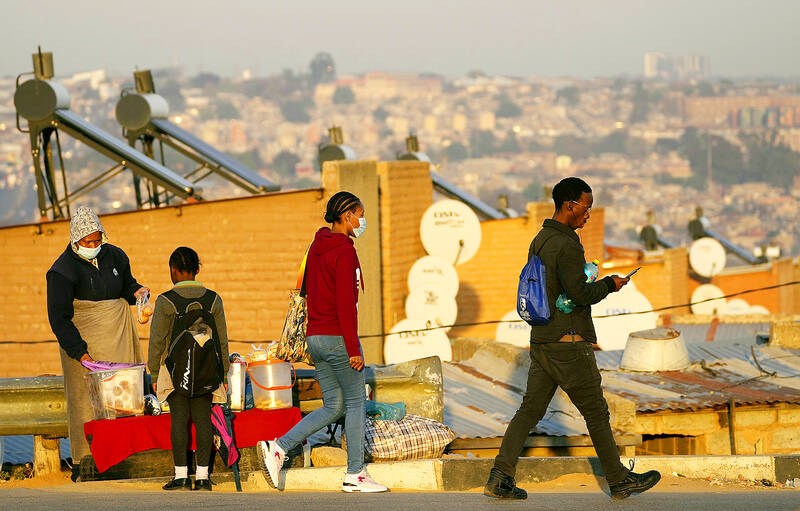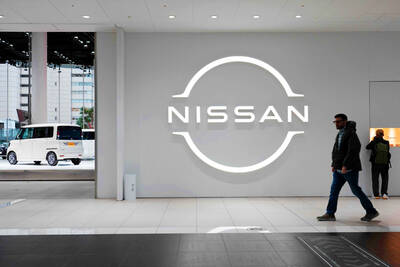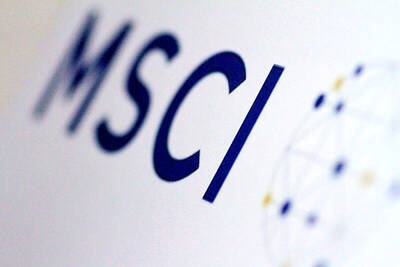For more than a decade, musician Thomas Nhassavele has been busking next to the parking payment machine at Johannesburg’s Rosebank Mall, where drivers often dropped their change into his guitar case.
However, Nhassavele’s takings have dwindled in the past few years as growing numbers of mall visitors use cards to pay at the machine’s new cashless payment system — some mumbling a quick apology to him before they head for the exits.
“There has been about a 50 percent reduction in donations since the mall installed cashless ticket payments. Many people just don’t want to carry money anymore,” he said, strumming his guitar.

Photo: AP
Cashless payments in the country are on the rise as customers are drawn to the convenience, safety and hygiene of tapping a card or scanning a QR code in post-COVID-19, crime-ridden South Africa — sometimes at the expense of the informal economy.
While analysts say the cashless move has boosted sales for small businesses, those dependent on loose change — buskers, street traders or fuel station attendants who rely on tips — say the shift has hit their earnings.
From Ghana to Kenya, the 59 billion cashless transactions carried out in Africa in 2020 are expected to nearly triple by 2030 to reach 172 billion, a report by PricewaterhouseCoopers (PwC) showed.
“We must accept that technology will change things, but I fear this cashless world will kill our income,” Nhassavele said, as a customer dropped a 1 rand (US$0.05) coin into his guitar case.
Smartphone penetration in South Africa has grown from 48 to 78 percent in the past four years, while the number of South Africans over the age of 15 with bank accounts rose from 54 percent in 2011 to 84 percent last year, World Bank data showed.
This lays a strong foundation for cashless payments, said Michael Thomson, creative director at SnapScan, a contactless QR code payment system that caters to 70,000 merchants across the country, and has 3 million downloads.
There are still barriers to increasing uptake.
While women in South Africa are more likely to have bank accounts than their peers in other countries in the region, a lack of financial literacy and discrimination keeps them from accessing the full potential of banking resources and opportunities, University of Johannesburg research showed.
Navigating cashless systems typically requires a bank account, a cellphone number, Internet access and digital literacy — not all of which are available to those without identification documents or smartphones, including refugees and the homeless.
“The formal payment system and its innovations tend to be utilized by the higher-income markets rather than the lower-income or under-developed sectors of the economy,” said Chantal Maritz, head of PwC’s strategy and payments team in South Africa.
Nearly 30 percent of South Africa’s economy is informal, the World Economics data Web site showed.
Of the South Africans with bank accounts, 25 percent — or 8.3 million people — are underbanked, meaning they cannot access full banking services, Maritz said.
“Although digital payments don’t require a bank account, such street vendors, buskers and beggars would require a digital store of value that holds their digital money to make and accept payments,” she said.
That could include a bank-linked e-wallet.
Another group of workers feeling the cashless pinch in South Africa are fuel station attendants who fill up customers’ vehicles, clean the windscreen and then — if the customer wants to pay on a card — bring the payment terminal to the driver.
“Drivers want to tap and go. This is bad for us as tips don’t always come when people use cards,” said Lebogang Ramathoka, an attendant at a Johannesburg gas station, adding that tips had earlier made up more than 30 percent of his monthly wage.
Some gas stations have started letting customers add a tip to their card payment, Ramathoka said.
“There should be an option on the card machine that asks them if they want to add a tip for us. It’s less awkward than us having to ask them,” he said, sipping a drink at a table behind the petrol station during his break.
A slew of other payment options aimed at popularizing cashless payments have been launched in the past few years, from First National Bank’s e-wallet that lets customers send money to a cellphone number, to Yoco’s wireless card machine and Zapper and SnapScan’s QR codes.
Yoco is a portable South African card machine used by 250,000 South African businesses that connects to a cellphone over bluetooth, and offers free, unlimited 4G data and WiFi connectivity, taking less than a 3 percent fee on payments.
Yoco and SnapScan say that car guards — people who watch over parked vehicles to ensure they are not stolen — who have bank accounts have begun giving drivers the options of cashless Yoco and SnapScan payments.
Timothy, a waste picker who also cleans the streets at traffic lights in Johannesburg, said his cellphone was his saving grace during COVID-19 lockdowns, as he could ask contacts to send him cash to his e-wallet.
“It’s the reason I survived,” he said, asking to only use his first name to protect his identity.
“Easier access to [the] identification documents and proof of address” needed to get bank accounts, digital wallets and SIM cards, would also open up cashless payment systems to marginalized groups, Thomson said.
However, gas station attendants such as Ramathoka hope the surge in cashless payments will not do away with cash altogether.
“People are on tight budgets, and a coin here or there is easier to give than swiping on a card,” he said. “If there are no coins to give, I fear we will struggle.”

PERSISTENT RUMORS: Nvidia’s CEO said the firm is not in talks to sell AI chips to China, but he would welcome a change in US policy barring the activity Nvidia Corp CEO Jensen Huang (黃仁勳) said his company is not in discussions to sell its Blackwell artificial intelligence (AI) chips to Chinese firms, waving off speculation it is trying to engineer a return to the world’s largest semiconductor market. Huang, who arrived in Taiwan yesterday ahead of meetings with longtime partner Taiwan Semiconductor Manufacturing Co (TSMC, 台積電), took the opportunity to clarify recent comments about the US-China AI race. The Nvidia head caused a stir in an interview this week with the Financial Times, in which he was quoted as saying “China will win” the AI race. Huang yesterday said

Nissan Motor Co has agreed to sell its global headquarters in Yokohama for ¥97 billion (US$630 million) to a group sponsored by Taiwanese autoparts maker Minth Group (敏實集團), as the struggling automaker seeks to shore up its financial position. The acquisition is led by a special purchase company managed by KJR Management Ltd, a Japanese real-estate unit of private equity giant KKR & Co, people familiar with the matter said. KJR said it would act as asset manager together with Mizuho Real Estate Management Co. Nissan is undergoing a broad cost-cutting campaign by eliminating jobs and shuttering plants as it grapples

The Chinese government has issued guidance requiring new data center projects that have received any state funds to only use domestically made artificial intelligence (AI) chips, two sources familiar with the matter told Reuters. In recent weeks, Chinese regulatory authorities have ordered such data centers that are less than 30 percent complete to remove all installed foreign chips, or cancel plans to purchase them, while projects in a more advanced stage would be decided on a case-by-case basis, the sources said. The move could represent one of China’s most aggressive steps yet to eliminate foreign technology from its critical infrastructure amid a

MORE WEIGHT: The national weighting was raised in one index while holding steady in two others, while several companies rose or fell in prominence MSCI Inc, a global index provider, has raised Taiwan’s weighting in one of its major indices and left the country’s weighting unchanged in two other indices after a regular index review. In a statement released on Thursday, MSCI said it has upgraded Taiwan’s weighting in the MSCI All-Country World Index by 0.02 percentage points to 2.25 percent, while maintaining the weighting in the MSCI Emerging Markets Index, the most closely watched by foreign institutional investors, at 20.46 percent. Additionally, the index provider has left Taiwan’s weighting in the MSCI All-Country Asia ex-Japan Index unchanged at 23.15 percent. The latest index adjustments are to